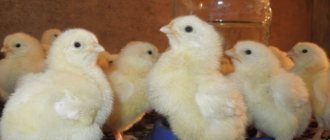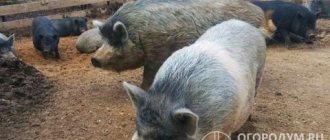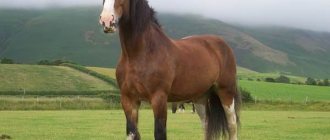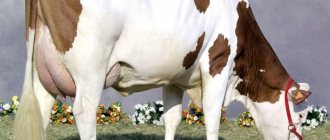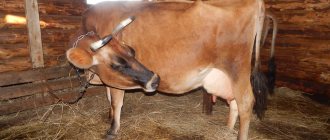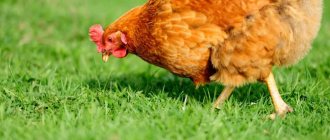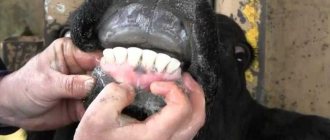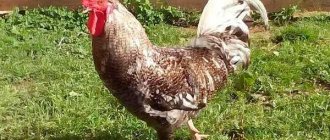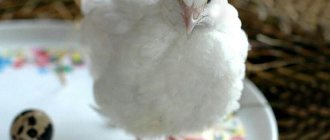The Aberdeen Angus breed of cows confidently ranks first in the ranking of the popularity of cattle. This hornless breed belongs to the meat category and is quite unpretentious in terms of keeping conditions. Breeding this productive and early-ripening breed is a profitable activity that allows you to obtain valuable “marbled” meat.
From the history of the breed
The Aberdeen Angus breed was developed in Scotland in the 19th century. Its name comes from the Scottish counties of the same name. Already at the end of the 19th century, 8.5 thousand Angus animals were delivered to the USA.
Red Angus were bred in the mid-twentieth century. But American breeders refuse to recognize their belonging to the breed.
In North America, black Angus breeding has become widespread, and their meat has become an ideal raw material for the famous American steaks. US farmers promptly organized the Angus Breeders Association, and then created a stud book, which includes only individuals that meet certain requirements.
Black Angus meat is a delicacy for meat-eaters and true gourmets
Aberdeen Angus is a meat breed; the taste of such beef is significantly different from the taste of meat from dairy cows. We recommend learning about the difference in tastes here.
Corn-fed Black Angus breeds produce marbled meat of impeccable quality. Without undue modesty, we can say that Black Angus is the best beef for cooking steaks. Juiciness, softness, ideal meat structure, delicate taste and alluring aroma - all these are the characteristics of mouth-watering steaks made from this beef. You can also prepare many other dishes from marbled meat: burgers, kebabs, cutlets, sautés: whatever you want! We invite you to purchase marbled beef in our store and see for yourself! After all, as you know, it is better to check once than to hear a hundred times. We are sure you will not regret it!
Where are they distributed?
Angus are widely reared in:
- Russia;
- USA;
- New Zealand;
- Japan;
- Canada;
- Great Britain;
- Argentina.
Huge black cows are very hardy - Scotland is not the warmest country, so the animals tolerate low temperatures and drought well.
The breed was brought to Russia in 1958. Since then, a gradual increase in their population began. Today they are raised not only for meat, but also used for breeding work to improve the characteristics of local Russian breeds. Places of distribution of the breed in Russia:
- Caucasus
- Stavropol region
- Altai
- Krasnoyarsk region
- Volgograd region
- Voronezh region
- Orenburg region
The breed is actively grown in Kazakhstan and Ukraine.
Where is marbled beef raised?
There are several countries that have succeeded in producing marbled beef. First of all, this is the USA. The Americans approached the issue of producing this delicacy very scrupulously: they developed standards, described them, and even published catalogs through which one could order marbled meat.
Another state that is actually the birthplace of marbled beef production is Japan. The ancient Kobe technology became widespread there. The cost of Japanese beef is incredibly high: the price for 1 kg reaches $500.
Currently, Australia is the leader in the market for marbled meat supplies to the CIS countries.
Features of the Aberdeen Angus breed
The main distinguishing feature of Aberdeen Angus cattle is the excellent taste of the meat product. Aberdeen meat has a special structure - thin layers of fat are evenly distributed throughout it. Aberdeen beef is the only meat that does not deteriorate over time. It doesn’t need to be eaten fresh – as it “ripens” it only becomes tastier.
Advantages of the breed:
- They are characterized by high meat productivity. High taste qualities of meat - due to thin layers of fat, meat acquires a unique “marble” structure.
- Large weight and size. They quickly gain weight and increase in size. To avoid obesity, it is important to ensure proper nutrition for livestock.
- Poledness (hornlessness). This is a dominant trait that is actively transmitted by Angus during crossing - in almost 100% of cases.
- Fast weight gain. Calves are born small, their weight is 22-23 kg and 25-26 kg for heifers and bulls, respectively. Heifers are inseminated at 14-15 months. And by the age of two years, bulls have the parameters necessary for slaughter.
- Easily acclimatize to difficult climatic conditions.
- When crossed, the advantages of the breed are well conveyed - meat qualities, precocity and hornlessness.
- Prolific. Retain reproductive abilities throughout life. Almost zero mortality in calves - they have strong immunity and excellent health. Females are excellent mothers.
- They live long. Average life expectancy is 28-30 years.
- Calving is easy. Calves are not large, so problems usually do not arise during calving.
- High productivity.
Delicacy beef production technology
Steaks are mainly made from this meat, so manufacturers cut the cuts into layers 3-5 cm thick (across the grain) or sell whole pieces of beef. Steaks are sold chilled, in vacuum packaging.
Maturation
After slaughter, unbleached (with skin) carcasses are bled and gutted, then kept in refrigerators. Raw materials do not enter production until maturation has passed. This process promotes the appearance of fat marbling and softening of muscle fibers. Types of exposure:
- Dry - temperature 1-4 degrees, humidity 75%, ripening duration 15-28 days. The meat acquires softness, pronounced taste and aroma.
- Wet - the beef is kept in vacuum packaging for up to 7 days. Meat pieces become more juicy, but the taste is less pronounced.
Cutting
After ripening, the carcass is cut into parts according to the standard procedure.
The cuts are used to make various steaks, the names of which are borrowed from American producers of the delicacy:
- Ribeye.
The meat is cut from the ribs. Thick edge, many fatty streaks. The prepared dish is juicy and tender. - Striploin (New York strip)
- sirloin. Thin edge, less marbled inclusions than in ribeye, but the taste and aroma are more intense. Best cooked on the grill. - Tomahawk
- loin on the bone (ribs). Similar to ribeye. - T
-bone is a rump with a minimal amount of fat, but very soft. It reveals the aroma and taste best over an open fire. - Flank
- flank. Flank meat is moderately tender, with thick fibers. Used for stewing. - Top Blade
- the outer part of the shoulder blade. The beef is juicy and tender, but takes a long time to cook. - Osso Buco
is a shank cut into cross steaks. The lean cut is ideal for stewing.
Constitution and exterior
Signs that allow you to unmistakably determine that this is a representative of the Aberdeen Angus breed:
- No horns. Moreover, both in cows and in bulls. The absence of horns complicates life only in the wild, but in home breeding this feature is simply a distinctive feature and dominant of the breed.
- Black suit. There are also Red Angus, whose belonging to the breed is denied by American farmers.
Appearance features:
- Head. Powerful and heavy. But small in size. The animal looks very harmonious - Aberdeen are the real elite of the cow tribe. The forehead is slightly moved forward - as if Angus are angry, the back of the head is narrow. The muzzle is neat and short.
- Torso. They have a wide, deep and heavy body - the cattle look very powerful and strong. The line of the back is almost flat - without deflections.
- Legs. They are forced to carry a large mass, so they are very powerful and muscular - this can be seen with the naked eye. There's a lot of meat on the legs. The legs are short, they stand firmly and evenly on the ground.
- Neck. She is almost invisible - her head seems to immediately go into her shoulders. This feature adds visual power and strength to the exterior.
- Loin and cross. The leg is round in shape, with well-developed muscles.
- Wool. Brilliant. Well protects from the scorching sun and wind.
If Angus are well fed, they have a round shape and look powerful and muscular.
Animal muscles are clearly visible through thin, loose and elastic skin. Angus are distinguished by thin bones - it makes up no more than 15-18% of the total carcass weight. Other parameters are given in Table 1.
Table 1
| Parameter | Breed standard |
| Oblique length of the body, cm | 135-140 |
| Height at withers, cm | 120 |
| Chest width, cm | 46 |
| Chest depth, cm | 67 |
| Live weight of cows/bulls, kg | 450-500/900-1000 |
| Slaughter yield, % | 62-67 |
| Average milk yield per year, l | 1700 |
Aberdeen are large and powerful animals, their appearance can even frighten. However, these black, strong creatures have a very docile character and are not known to show aggression. Only bulls at puberty can be quite ferocious.
What can you cook from marbled beef?
Our material provided information on how cows are raised for marbled beef. Now we will look at how you can use this meat. The most popular dish is steak, for the preparation of which you can use only a tenth of a cow carcass. There are several types of this dish:
- Crab steak, which is cut from the edge of the longest back muscle.
- Ribeye, for the preparation of which meat is taken from the subscapular part of the body. It contains a large amount of fat.
- T-bone is a T-shaped bone with meat. It is cut between the loin and the back, which is why it contains two types of beef fillet.
- Striploin, which is cut from the lumbar region. There are no bones in it.
- Roundramb is obtained from the hip area of the body, namely from the upper part.
- Porterhouse is also cut from the lower back.
- Skrit steak is marbled meat obtained from the diaphragm of a cow.
- Filet mignon is the most tender steak.
- Tornedos are slices of meat from which so-called medallions are prepared.
- Chateaubriand is almost the same as filet mignon. The main difference between these steaks is the presentation: chateaubriand is laid out lengthwise on a platter, while filet mignon is placed vertically.
Are there any disadvantages?
According to the description, the breed is magnificent, but does it really have no disadvantages? There are, but they are not so significant compared to the advantages:
- Weak legs.
A contradiction arises - it is simply difficult for a fattened animal to carry its body. Despite the development of the leg muscles, the strength of the legs is not enough to support the obese carcass - the animal begins to fall on its feet. This is why Aberdeen should not be overly fattened. Bulls will be sent to slaughter anyway, so weakness in the legs is not so important, but cows should not be allowed to be overweight! Obesity in cows leads to difficulty transferring weight during gestation and complications during calving. - Arched back. Connoisseurs of cow conformation claim that the carp-like back somewhat spoils the attractiveness of Angus. But this does not affect the quality of the meat in any way! This disadvantage even has its advantages - the structural features allow livestock to easily adapt to external environmental conditions.
- Need large pastures. That is why the breed is more suitable for farmland and hunting grounds.
Productivity
Cattle breeders raise black Scottish cows only for meat - that very valuable marbled beef. What you need to know about Angus productivity:
- The carcass yields 60% pure meat - this is extremely high productivity.
- The female weighs on average 500-600 kg, and if she is fattened purposefully - 700 kg.
- Bulls reach 1000 kg. They are slaughtered at a young age - while the meat is soft and tender. The ideal age for slaughter is 1.5-2 years.
- Over six months, the calf gains weight 152-158 kg - from 22-28 (calf weight) to 180 kg.
Tasters specializing in meat can determine by taste the age at which the animal was slaughtered. It has been noticed that over the years, Aberdeen meat becomes tougher, but in all other respects it only improves.
Angus are the clear leaders in early maturity and meat characteristics among beef cattle. The weight of cows depending on age is presented in Table 2.
table 2
| Periods of life | Floor | Weight, kg |
| at birth | chicks | up to 20 |
| bulls | until 23 | |
| 7-8 months | chicks | 160-180 |
| bulls | 180-200 | |
| 16 months | fattening bulls | 450-460 |
| adult | cows | 500-700 |
| bulls | 750-1000 |
Being on suckling for up to 8 months, calves gain 800-900 g per day. And one cow produces 1600-2000 liters of milk during lactation. Typically, lactating cows are not milked - the milk is used to feed the calf. After 8 months of the dairy kitchen, the calf will weigh about 230 kg.
Beer and reins
Article on the topic Massage for cows.
Milk milking is controlled by computers and Vivaldi music. However, the Japanese say a lot about marbled meat and have the right to do so: cows of a special breed were raised exclusively in the Land of the Rising Sun for a long time and were not exported to other countries! The “growing” of marbled meat is overgrown with juicy myths and legends. The Japanese claimed that young calves are fed milk for 4-6 months, then released to graze on ecologically clean meadows - and certainly without any “human presence”, after which the calves are placed in soundproof (!) apartments, suspended on reins (so that the muscles of the calves are under constant tension to ensure even distribution of fat). They are fed selected barley and given beer to drink to improve their appetite, in addition, they regularly give them massages and... play Japanese classical music. When Japanese bulls were crossed with the equally “marbled” Scottish Aberdeen Angus, new valuable breeds began to be bred in Australia, Argentina, the USA and other countries, without beer or music. The imported breeders of marbled beef had one thing in common: a strong belief that Russia would never be able to handle such complex “livestock technology” in its life and we could only buy meat at the price of real marble. This is how it was for a long time: we relied on the production of chicken and pork, but few people wanted to tinker with beef, especially elite beef. But with the introduction of sanctions, it turned out that we not only can “make” marbled beef no worse than foreigners, but, it turns out, we have been doing this for a long time - in Lipetsk, Voronezh, and the Leningrad region. Imports simply prevented development...
Photo: Shutterstock.com
Content requirements
For the growth and development of Aberdin, a natural food supply is sufficient - they need extensive pastures, natural or artificial meadows. They tolerate cold and heat well, so as long as snow does not fall and frosts do not hit, they can graze on the paddock.
Angus dogs can be free ranged all year round.
Recommended walking conditions:
- It is desirable that shrubs and trees grow along the perimeter of the pasture - then animals can wander around, chewing grass, without any supervision or care.
- If there are no trees nearby, it is recommended to make a canopy from the sun so that animals can hide under it during the high solstice hours.
- The main task of the herd owner is to provide the cattle with water and mineral supplements; the cows will find everything else themselves. In the absence of a natural reservoir, you need to organize drinking bowls.
- When keeping a barn, it is important to keep everything clean - remove manure and any debris.
Thanks to its natural content, livestock meat acquires a special taste - delicate and refined.
If Angus have water and food, they can stay outside even during the cold season. In winter, cattle can be driven into barns - here they are kept without a leash. Moreover, there is no need to insulate the room - animals warm themselves from the heat generated by their bodies.
Experts talk about the peculiarities of keeping the Aberdeen Angus breed outdoors. The video shows a special feedlot for livestock:
The best beef breeds of bulls for the Russian climate
There are beef bulls of different origins and nationalities in the world, they all differ from each other in the quality of meat, different care and maintenance, and most importantly they can be distinguished by their appearance and how they acclimatize in different countries, and especially in Russia.
British beef bulls
British bulls are distinguished by their noticeable body weight; the meat of these animals has high taste, a pleasant aroma and has a thin layer of fat, which makes it even more tender and at the same time juicy. Due to the peculiarities of the local climate, representatives of this breed have some fur. Bulls of the British breed are bred all over the world, but they can be especially often found in Russia, since they are able to withstand any climatic conditions, even the most severe.
Aberdeen Angus
This breed was developed in Scotland in the 21st century. In 1878, the herd was transported to the United States of America, and then to other parts of the world. Since then the breed has become famous. The bones of these bulls are strong and at the same time thin, and the body has a rounded shape. Their legs are not long, but since the body is extensive, the height at the withers is one and a half meters. The weight of one bull can reach one ton.
The head is small in size, the neck is practically absent, the head immediately merges with the shoulders. Males of this breed do not have horns. The color can be either red or black. The meat is marbled, the yield per carcass is 60%, with very little fat. Beef of this breed is famous for its great popularity in Russia. Calves gain weight quickly, which adds to farmers' profits.
Hereford
The Hereford breed was developed in the 18th century. She is one of the most popular around the world. The body is barrel-shaped and wide, the muscles are well developed. The weight of one male can reach from 900 to 1300 kilograms. Their legs are strong and their necks are short. The bull itself is red, and the tip of its tail and legs are white. The height reaches no more than 130 centimeters.
Cattle of this breed quickly get used to any climate, can travel long distances, and are not fussy in maintenance and care. They are kept both in Russia and in other countries, and even in the North they feel great and delight with good, juicy meat. The slaughter yield from one carcass is 70% marbled delicious meat. The mortality rate of newborn calves is very low, with one baby gaining about one kilogram of weight in one day.
Such animals can be kept on pasture ranges even in winter; they adapt to any climatic conditions in a few days. Therefore, Hereford bulls are often bred by Russian farmers, because in addition to the fact that they are not fussy in maintenance and care, bulls also quickly gain weight.
The only disadvantage of these bulls is that they eat a lot; in one winter, 15 heads eat about 200 tons of hay alone. Therefore, before deciding to own Hereford bulls, you need to purchase haymaking equipment. They are also afraid of drafts; if they are present, the bulls lose their appetite and, accordingly, their weight, so all cracks must be sealed.
Shorthorn
This breed was developed in Great Britain in the 18th century. Bulls are covered with thick, short hair, so they are not kept in the southern regions. Animals quickly get used to climate change and are used for breeding. These bulls are good to keep in a humid temperate climate; they cannot be kept in the North. If a decision is made to breed bulls in cold regions, then they are kept exclusively in barns, where the temperature does not fall below 15 degrees.
The constitution itself is loose, but the skeleton is strong, the body is wide, the legs are short, but at the same time strong. Their belly is white, their legs are covered with white spots, and the bull itself is red. The head is proportional to the neck and back, the sides are like a round barrel, the chest is wide, and the dewlap protrudes.
The weight of one bull can reach 950 kilograms. The color of these animals can be different: red and white, white, red or red. Marbled meat is juicy and fibrous. Slaughter yield per bull is 70%. The young animals are precocious, but the same cannot be said about their fertility - unfortunately, it is low.
This breed is not so popular, since bulls are whimsical in feeding, preferring the best food. They are also susceptible to infectious diseases, so it is necessary to receive all necessary vaccinations.
Gallowaysky
This breed can be kept on pasture all year round. They don’t care about any climate or any weather. This breed is not popular in all countries; a particularly large number of them can be found in Siberia. As for the native country of Scotland, only a few of these bulls can be found there, since they are considered an obsolete meat breed.
The body is long, the bones are strong. There is hard, thick hair about 20 centimeters on the body. The weight of such bulls can reach 800 kilograms of live weight. The bulls are distinguished by their early maturity; their daily weight gain is 1100 kilograms. The slaughter yield per bull is 67%, while the meat is lean, tasty and juicy.
The color of bulls is mostly black, with a wide stripe of white from the shoulder blades to the waist; dark brown, light yellow and white bulls are less common. Their height is short, their body is elongated, and their muscles are well developed.
French bull breeds
The following breeds of bulls were bred in France and are in great demand; today they are popular in Russia. The most delicious and most expensive cheeses are made from the milk of French cows.
Salersky
This breed of bulls was bred in the 19th century; the well-known Saler cheese, which belongs to the noble category, is made from the milk of cows. Saler bulls are bred in 25 countries around the world. The body is dense, bulls are not very tall - up to 150 centimeters. The bones are strong, the horns are strong, the legs are strong and even. The color is dark red, the weight of an adult bull can reach 130 kilograms. Marbled meat is fatty.
Bulls are highly productive, so this breed is often bred in Russia and beyond. Tasty and juicy meat with a minimum of fat can be obtained with proper and rational feeding.
Aquitaine
This breed was developed in France in 1962. The color is wheat, light brown. Appearance: The body is muscular and wide, as well as elongated. The weight of an adult wild boar can reach 1300 kilograms. Newborn calves weigh 45 kilograms, and the daily gain is 2 kilograms, provided that they are on proper rational feeding. The slaughter yield of meat per carcass is 70%, the meat has high taste.
Bulls can easily withstand both harsh winters and hot summers and quickly adapt to any climatic conditions. To get the maximum amount of meat, animals should be kept in the fresh air as long as possible. Aquitaine bulls are popular in all territories of Russia, because they are not fussy in their maintenance, are not prone to diseases, and quickly acclimatize.
Central Asian bulls
Central Asian bulls are famous for their ease of keeping and feeding. They can eat any food, even cheap, while maintaining good health and good weight gain. The peculiarity of these bulls is that they can easily withstand even severe frosts.
Kalmyk
This breed was bred in the 17th century in Kalmykia from bulls and cows of the Mongolian herd. This breed has a strong bone structure, a dense body, and a wide body. The height of one bull can reach 130 centimeters. As for body weight, it is approximately 1100 kilograms. The color can be red, red-motley, red with white spots, brown-motley.
The daily weight gain of the calf is 1 kilogram. The slaughter yield is 60%. The meat is juicy, has high taste with a small amount of fat. About 400 years ago, the breed gained trust in Russia, and they are bred everywhere, from Siberia to the Volga region and the Don shores.
Kazakh
This breed of cow was invented in the 20th century by crossing a Kazakh bull and a Kalmyk cow. The body is wide and barrel-shaped. The bones are strong, massive, muscle mass is well developed. The color of bulls is red, and the tip of the tail, head, legs and belly are white. The height of one bull can reach 130 centimeters.
As for weight, with good maintenance and feeding it exceeds 950 kilograms. The daily weight gain of young animals is 1500 kilograms. Kazakh bulls are early maturing, the slaughter yield of one carcass is 60%. The meat is tasty and juicy, and there is a thin layer of fat between the muscles.
Kazakh bulls can often be found in the middle and lower Volga region, Saratov and Orenburg regions. You can buy the best bulls in the Urals at the Chapaevsky and Ankantino plants.
Nutrition
The basis of the diet of Aberdeen cats, which graze on range most of the year, is green food. Since there is no food on the streets in winter, the cattle are given high quality food:
- silage;
- hay;
- roots;
- crushed grain;
- compound feed
It is important to follow nutritional standards so that the livestock does not become fat. Cattle of this breed have a high feed conversion rate. For an animal to gain 1 kg of weight, it needs to consume 6.5 kg of feed units, this can be:
- dry oats – 6.5 kg;
- or meadow grass – 32.5 kg;
- or hay – 13 kg.
Mineral supplements:
- bone flour;
- defluorinated phosphate;
- tricalcium phosphate;
- diammonium phosphate and others.
In order for the meat to have the excellent taste characteristic of this breed, it is not necessary to use concentrates for feeding.
Constantly being on pastures, good-tempered Angus can show distrust of the owner - they simply forget about his existence. It happens that cows try to leave the herd - this must also be taken into account when breeding Aberdeen. Another problem is the maternal instinct of cows. The female may attack a person if she decides that her calf is in danger. And even the absence of horns in Angus will not help a gape person.
A few words about fattening Aberdeen Angus
A healthy and proper diet for bulls is the most important component in obtaining high-quality marbled meat. It is simply impossible to hide improper nutrition: the marbling of meat directly depends on the diet of the animal.
From birth, calves are fed by their mother - cows have a well-developed maternal instinct - which contributes to the development of strong immunity. Then the animals begin to be fed with hay, gradually adding four types of corn. The ideal conditions for obtaining premium beef are 180-day corn-fed. Before slaughter, animals are kept in a stall to reduce their activity so that the meat reaches perfect marbling. A properly raised bullock produces at least 350-400 kg of premium meat with impeccable taste characteristics.
Fattening
The best meat comes from castrated bulls. Castration is also carried out in calves. Thanks to castration:
- meat fibers become thinner and meat more tender;
- bulls can graze in the same herd with cows; there is no need to organize a separate pasture for them;
During fattening, the basis of the diet is:
- crushed grain;
- hay;
- compound feed - however, they worsen the taste of meat;
- premixes – vitamin and mineral.
Feeding rates for livestock during fattening, giving an average daily weight gain of up to 800 g, are given in Table 3.
Table 3
| Index | Age, months | |||||
| 9-10 | 11-12 | 13-14 | 15-16 | 17-18 | 19-20 | |
| Live weight at the end of the period, kg | 245 | 290 | 335 | 380 | 425 | 470 |
| EKE | 5,9 | 6,3 | 6,6 | 7 | 7,4 | 8,1 |
| Metabolic energy, MJ | 59 | 63 | 66 | 70 | 74 | 81 |
| Dry matter, kg | 6,4 | 6,8 | 7,2 | 7,7 | 8,2 | 9 |
| Crude protein, g | 800 | 820 | 848 | 920 | 965 | 1059 |
| Digestible protein, g | 525 | 560 | 565 | 605 | 632 | 677 |
| Crude fiber, g | 1570 | 1700 | 1870 | 2090 | 2370 | 2491 |
| Starch, g | 768 | 813 | 879 | 980 | 1066 | 1170 |
| Sugar, g | 390 | 398 | 400 | 416 | 430 | 472 |
| Crude fat, g | 180 | 194 | 207 | 230 | 240 | 263 |
| Table salt, g | 31 | 34 | 36 | 40 | 42 | 46 |
The farmer tells how the farm organizes the fattening of bull calves for meat, and what are the features of their feeding:
Breeding
Breeding Angus is a profitable business, as their young animals have a high survival rate. Calves are born strong, with good immunity. Feeding on mother's milk, they receive the entire complex of minerals and vitamins.
From 14 months, cows are ready for insemination. They can bear offspring annually. Aberdeen cows often give birth to two calves at once. They are caring mothers:
- feed the calf daily - up to 8 months;
- looks after the offspring;
- protects his calf from any danger.
Cows and calves can be safely released to free grazing - the females will take care of the protection of the young.
A cow's pregnancy lasts 9 months. The birth goes smoothly. Typically, farmers keep 1-2 bulls to improve the herd.
Features of cultivation
So, how are cows raised for marbled beef? It is very important to properly care for animals. Throughout the year they are kept free-range, allowing them to be in an environment close to natural. There they feed on meadow grasses and gain strength.
Then, approximately 3-4 months before slaughter, they are transferred to feedlots. During this time, the animals eat a special cereal mixture, the main ingredient of which is wet corn. At the same time, cows and bulls are restricted in their movement. We briefly looked at how to raise marbled beef, now we will dwell in more detail on the main aspects of this process and list the factors that affect the marbling of meat.
How is calving going?
The room must be dry and clean. Stock up:
- two towels;
- gauze;
- soap;
- iodine;
- threads;
- bandage;
- 100 g vegetable oil;
- warm water;
- potassium permanganate solution;
- sheets;
- burlap;
- straw rope.
As soon as the cow begins to show anxiety and starts looking around, you need to wash the back of the body and genitals with potassium permanganate. The solution is made slightly pink. Lay dry straw near the cow.
Less than an hour later, the calf is born. It is placed on a clean sheet. The umbilical cord breaks on its own; if it does not break, it must be cut off, leaving 10 cm from the calf’s belly. All that remains is to tie the umbilical cord with threads and treat it with iodine.
Diseases
From a genetic standpoint, black and red Angus breeds are identical. But it is believed that red cows are less cold-resistant. However, there is no scientific evidence for this. Aberdeen are carriers of 4 recessive genetic diseases. They appear when both parents have the gene. According to statistics, even under such conditions, only one out of 4 calves gets sick.
To identify carriers of bad genes, a DNA test is performed on individuals.
Genetic diseases:
- Contracture arachnodactyly. There is a deterioration in the mobility of the hip joints.
- Arthrogryposis multiplex . Crooked joint disease. Breeders call calves with this condition “twisted.” The joints have poor mobility, and the leg muscles are atrophied.
- Neuropathic hydrocephalus . It is also called dropsy of the brain. Calves have large, shapeless heads.
- Dwarf traits.
- Notomelia. Extra limbs.
- Osteoporosis. Brittle bones.
Calves with such genetic diseases are culled - they are not suitable for breeding. A cow's pregnancy lasts 9 months. The birth goes smoothly. Typically, farmers keep 1-2 bulls to improve the herd. Purebred Aberdeen Agnus cows should be purchased from breeding farms. Here you can get material for insemination.
Breeding farms in Russia that have breeding stock:
- "Paris Commune" - in the Volgograd region;
- "Avryuz" - Bashkortostan;
- LLC "Sputnik" - in the Leningrad region. Vsevolzhsky district, village. Lepsari;
- State Unitary Enterprise ESH "Dyatkovo" - in the Bryansk region. and many others.
Calf care
The keeping of calves is divided into milk and post-milk periods. The most important stage in the life of a calf of any breed is the first two weeks. Angus breed very strong offspring. The mortality rate is practically zero. Conditions for keeping calves during the first 14 days:
- Calf nurseries should be located in a room with good ventilation and lighting.
- The barn where the calves are kept must have a constant temperature.
- There should be no drafts. Calves have poorly developed body thermoregulation, and changes in temperature will negatively affect their health. Angus, having a strong immune system, unlike calves of other breeds, practically do not get sick.
- The nursery must be kept clean to prevent infectious diseases.
Calves get all their nutrients and immune substances from colostrum, which is the nutritional fluid the cow gives after calving. Immediately after birth, the calf must suckle the udder.
Please note the following points:
- For the first time, the calf should drink 1-2 liters of colostrum.
- The frequency of feedings should be 4-5 times a day.
- If the calf is weakened, it should eat more often - 5-6 times 1 liter, then 2 liters.
- The daily norm of colostrum is 8-10 liters.
- On the 5th day, the calf is given boiled water. Its temperature should be the same as that of fresh milk – 37 °C.
- From the 7th day - to develop digestion, calves are given small-stemmed, high-quality hay.
Calves are weaned from their mother at the age of 6-8 months. Calves enter the post-milk period of development. Calves need to get enough sun to produce vitamin D, which is needed for bone growth. Gradually, the calves switch to an adult diet, walking on pastures with cows, they have access to nutritious green food.
Beef maturing
Now you know how to raise marbled beef. The meat also needs to be processed. This is an integral part of the production process. Beef that meets international standards undergoes a maturing process, as a result of which the meat acquires excellent taste and becomes softer.
The first method of ripening is wet. Fillet without blood is packaged in vacuum bags, having previously cooled it to 0 ° C. Then, within 10-21 days, it ripens without access to oxygen. Dry ripening is a more labor-intensive process. In this case, the meat is hung by the bones in a refrigerated room, without removing any skin or fat.
Comparison with “competitors”
Angus differ from other breeds:
- Good health and low mortality among calves.
- They rarely get sick, and even genetic diseases affect only 25% of calves if both parents have the disease gene.
- They can graze on range all year round.
- Lactating calves – up to 8 months, instead of 3.
- Calves are born small - only 16-23 kg, while in other breeds - 20-30 kg. Therefore, childbirth is easy and without complications, even in first-calf heifers.
- Calves can graze with their mother from the first day of life.
- They are characterized by high early maturity.
Main competitors:
- Herefords. This is the most common breed. They, like Angus, can easily withstand harsh conditions and can graze year-round. They are distinguished from Angus by their more powerful front part. In many ways, the breeds are similar; Herefords are also distinguished by easy calving, fertility, low calf mortality, longevity, and high feed conversion. And most importantly, they also produce excellent “marbled” meat.
- Simmentals. Another popular meat breed. They are also large and muscular, like the Aberdeen. In addition, Simmentals are characterized by high milk production. The meat is devoid of excessive fat deposits, but in terms of taste it is inferior to Hereford Angus meat.
- Limousines. Like Aberdeen, they are distinguished by easy calving and good weight gain; their meat contains little fat. But they are extremely demanding in terms of food and living conditions; they are considered conditionally suitable for year-round grazing.
Table No. 4 shows a comparison of the economically useful qualities of Angus, Simmental, Hereford and limousine:
Table 4
| Indicators | Bulls | Cows | ||
| Herefords | ||||
| Height at withers, cm | 140-150 | 135-140 | ||
| Weight, kg | 1000-1200 | 600-750 | ||
| Daily weight gain of calves, g | 900-1300 | 850-1100 | ||
| Angus | ||||
| Height at withers, cm | 130-150 | 120-140 | ||
| Weight, kg | 900-1200 | 500-700 | ||
| Daily weight gain of calves, g | 1000-1200 | 850-1100 | ||
| Simmentals | ||||
| Height at withers, cm | 150-160 | 140-145 | ||
| Weight, kg | 1200-1400 | 750-800 | ||
| Daily weight gain of calves, g | 1200-1400 | 900-1200 | ||
| limousines | ||||
| Height at withers, cm | 145-155 | 135-140 | ||
| Weight, kg | 1000-1200 | 650-700 | ||
| Daily weight gain of calves, g | 1100-1300 | 900-1100 | ||
The Aberdeen Angus breed is a real treasure of livestock breeding. This breed is one of the few that does not require special care - the animals are ready to live in their natural environment all year round. They do not require supervision; care for the herd is minimal. By breeding Angus, you get a precious product - unique, juicy meat that is highly valued.
0
0
Copy link
How to cook marbled beef?
Marbled fillet can be fried in a frying pan or grill. A juicy and fatty rib cut is best suited for this. In restaurants, such dishes are served most often. The steak is thoroughly fried at a temperature of 160 °C. Cook the meat over low heat. To heat it evenly on all sides, you need to turn the product often. This will allow the steak to be well-cooked from the inside and achieve a golden crust. The fat rim is cut off only after the meat is completely cooked. Potatoes and other vegetables are served as a side dish for marbled beef.
